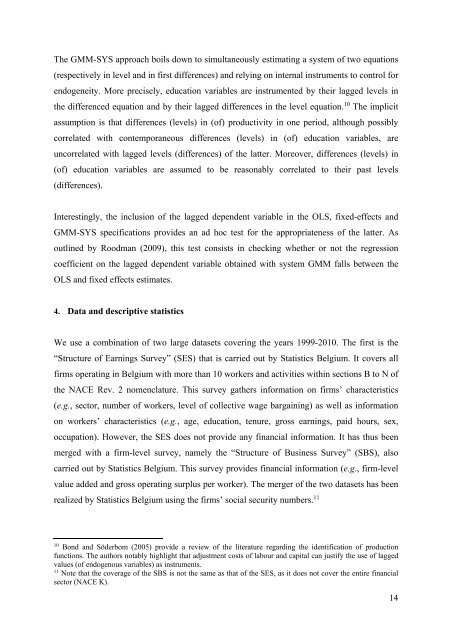CEB Working Paper
240798&r=lma
240798&r=lma
Create successful ePaper yourself
Turn your PDF publications into a flip-book with our unique Google optimized e-Paper software.
The GMM-SYS approach boils down to simultaneously estimating a system of two equations<br />
(respectively in level and in first differences) and relying on internal instruments to control for<br />
endogeneity. More precisely, education variables are instrumented by their lagged levels in<br />
the differenced equation and by their lagged differences in the level equation. 10 The implicit<br />
assumption is that differences (levels) in (of) productivity in one period, although possibly<br />
correlated with contemporaneous differences (levels) in (of) education variables, are<br />
uncorrelated with lagged levels (differences) of the latter. Moreover, differences (levels) in<br />
(of) education variables are assumed to be reasonably correlated to their past levels<br />
(differences).<br />
Interestingly, the inclusion of the lagged dependent variable in the OLS, fixed-effects and<br />
GMM-SYS specifications provides an ad hoc test for the appropriateness of the latter. As<br />
outlined by Roodman (2009), this test consists in checking whether or not the regression<br />
coefficient on the lagged dependent variable obtained with system GMM falls between the<br />
OLS and fixed effects estimates.<br />
4. Data and descriptive statistics<br />
We use a combination of two large datasets covering the years 1999-2010. The first is the<br />
“Structure of Earnings Survey” (SES) that is carried out by Statistics Belgium. It covers all<br />
firms operating in Belgium with more than 10 workers and activities within sections B to N of<br />
the NACE Rev. 2 nomenclature. This survey gathers information on firms’ characteristics<br />
(e.g., sector, number of workers, level of collective wage bargaining) as well as information<br />
on workers’ characteristics (e.g., age, education, tenure, gross earnings, paid hours, sex,<br />
occupation). However, the SES does not provide any financial information. It has thus been<br />
merged with a firm-level survey, namely the “Structure of Business Survey” (SBS), also<br />
carried out by Statistics Belgium. This survey provides financial information (e.g., firm-level<br />
value added and gross operating surplus per worker). The merger of the two datasets has been<br />
realized by Statistics Belgium using the firms’ social security numbers. 11<br />
10<br />
Bond and Söderbom (2005) provide a review of the literature regarding the identification of production<br />
functions. The authors notably highlight that adjustment costs of labour and capital can justify the use of lagged<br />
values (of endogenous variables) as instruments.<br />
11<br />
Note that the coverage of the SBS is not the same as that of the SES, as it does not cover the entire financial<br />
sector (NACE K).<br />
14


